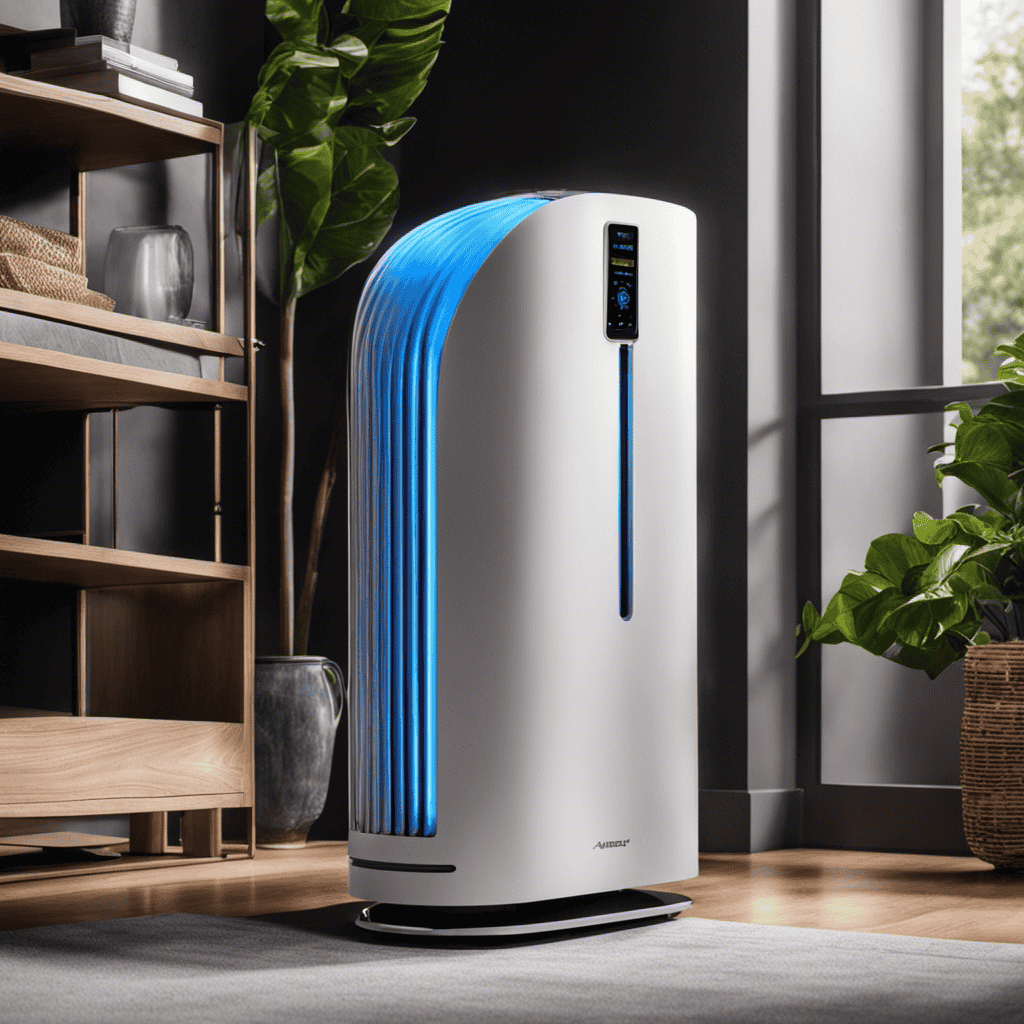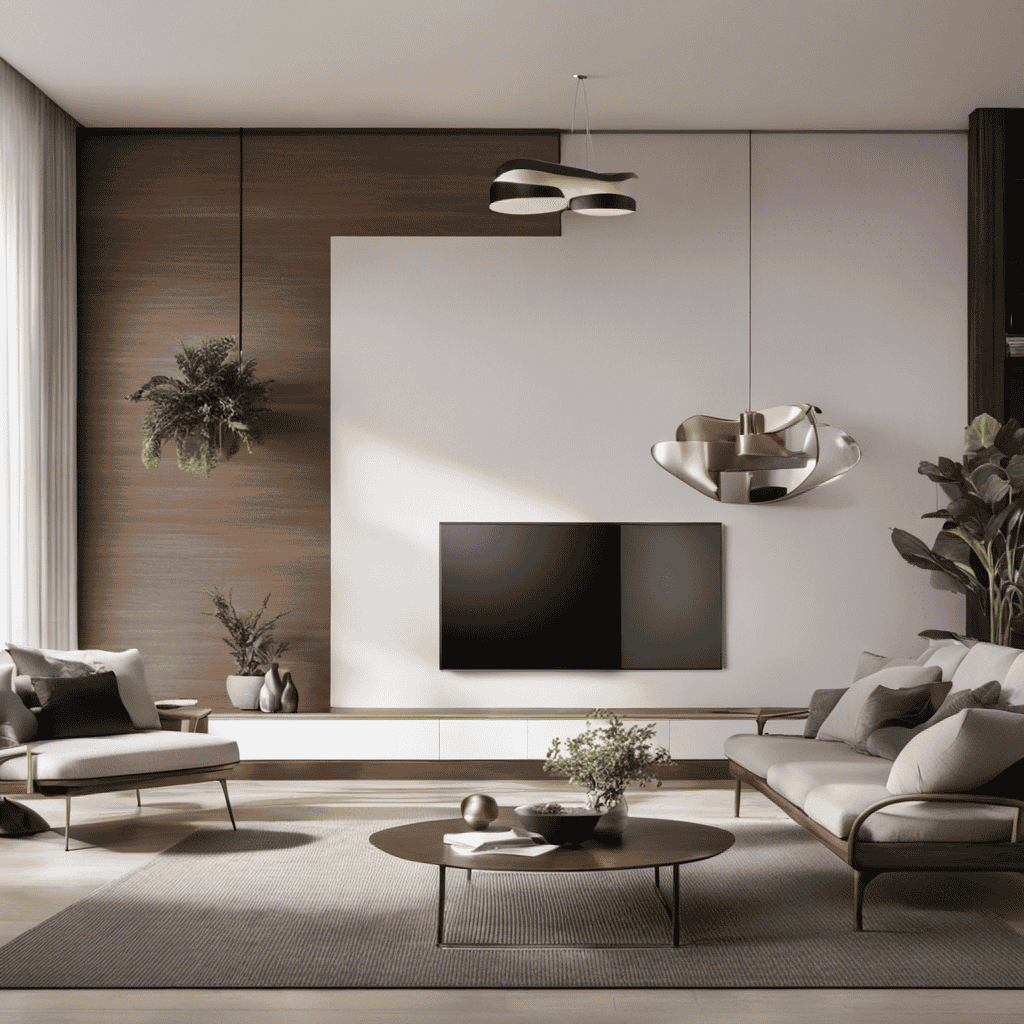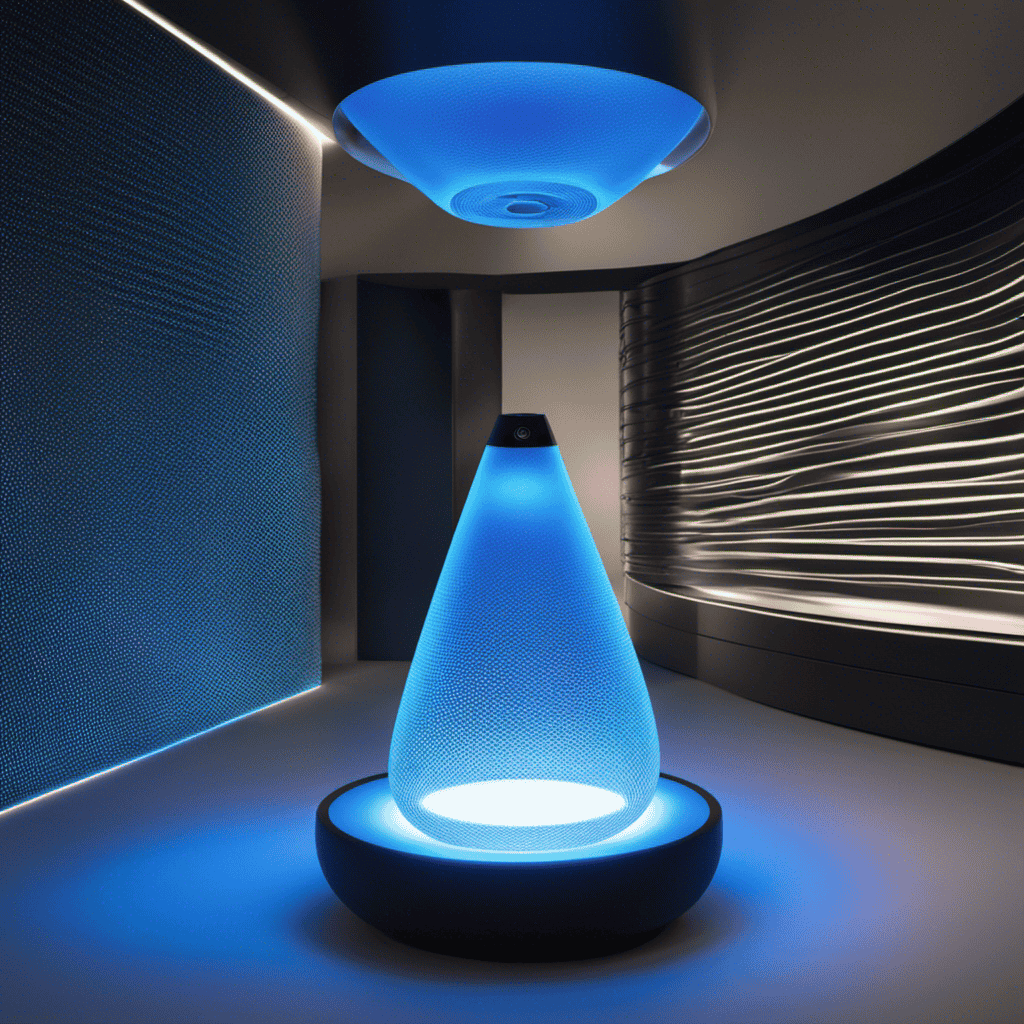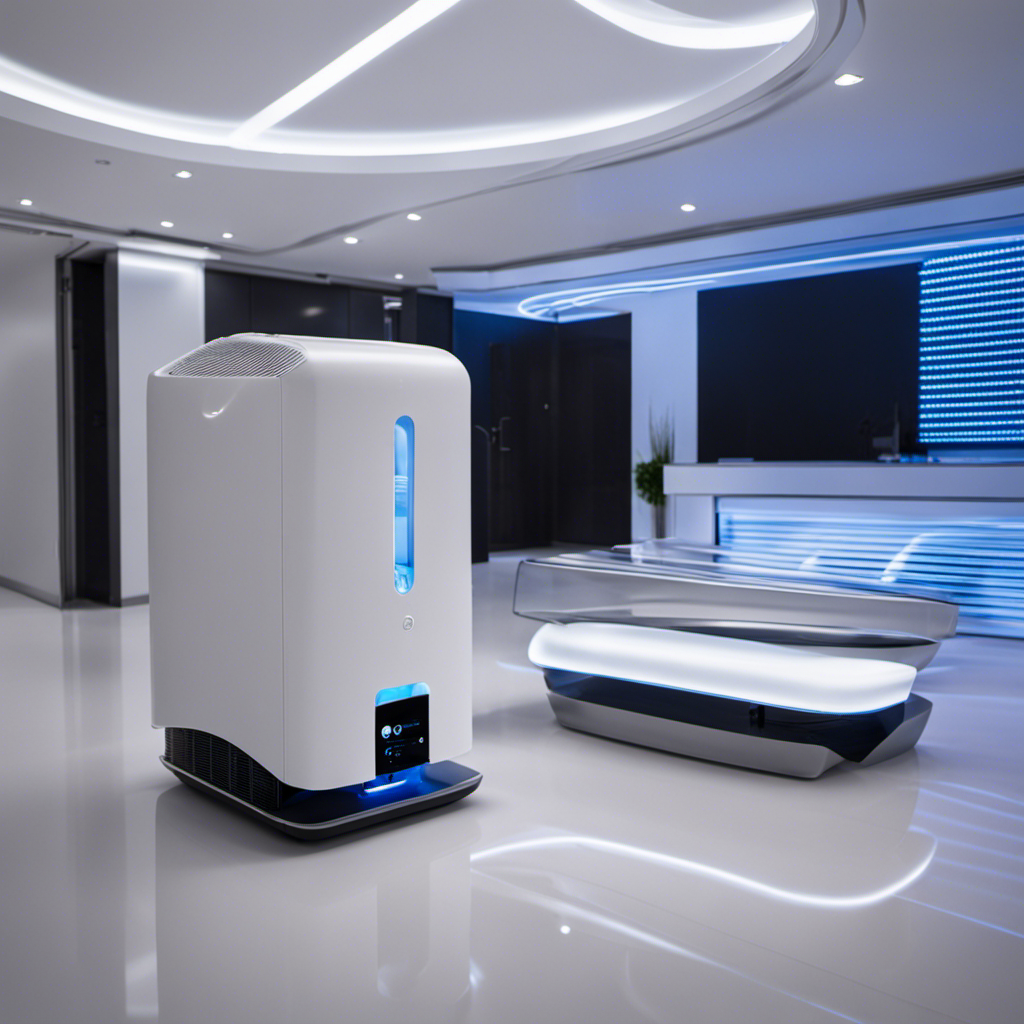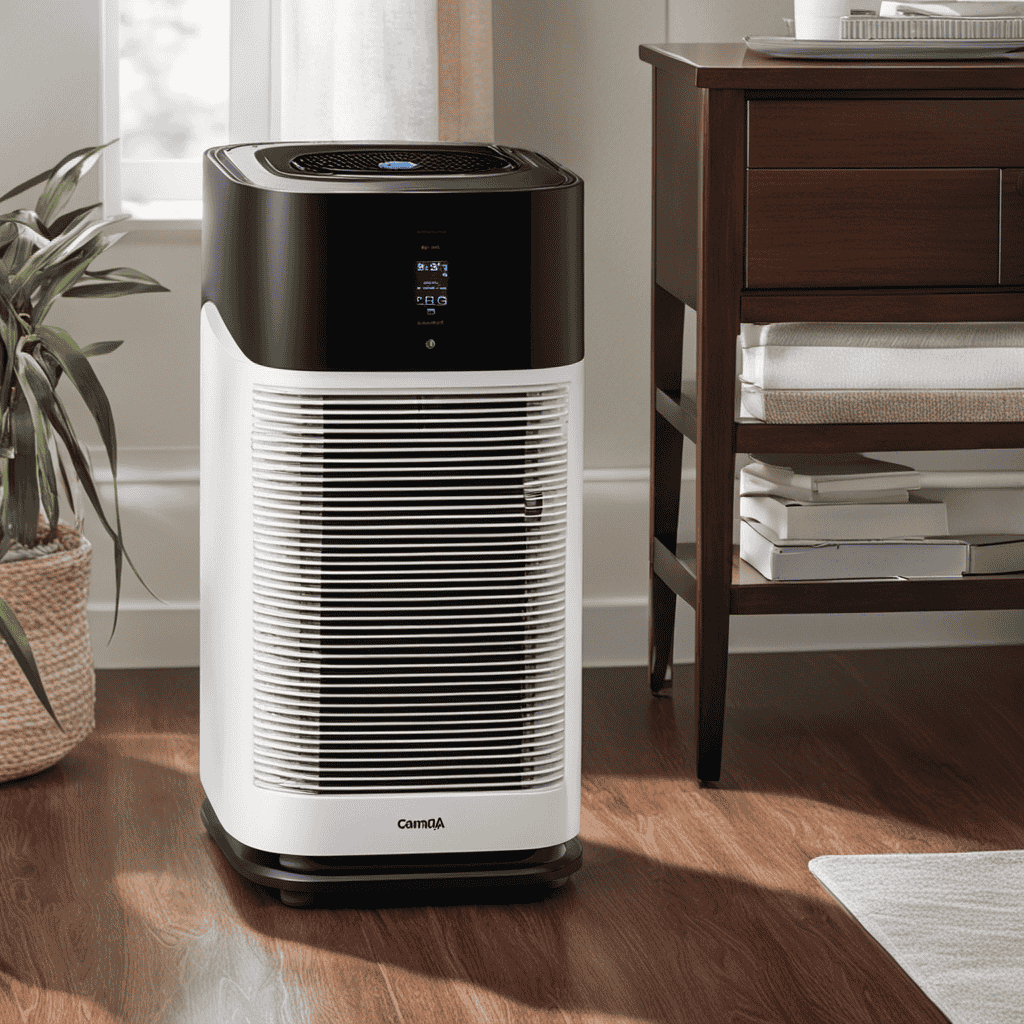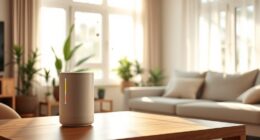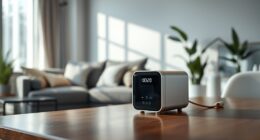As an individual who has dealt with allergies and respiratory problems, finding the perfect air purifier has felt like looking for a needle in a haystack. That’s why I was ecstatic to come across the UV setting on air purifiers.
In this article, I’ll delve into the inner workings of this feature, its benefits, and how it utilizes UV-C light for effective air purification. We’ll also explore factors to consider when choosing an air purifier with this setting and dispel common misconceptions.
So, let’s dive in and shed some light on the UV setting on air purifiers.
Key Takeaways
- The UV setting on an air purifier uses ultraviolet light to neutralize airborne contaminants by destroying their genetic material.
- While highly effective, prolonged exposure to UV light can pose potential health risks, so it is important to follow manufacturer’s instructions and take necessary precautions.
- Using the UV setting on an air purifier significantly improves indoor air quality and helps prevent the spread of germs.
- UV-C light, which is used in air purification, is a powerful tool that destroys harmful microorganisms in the air by damaging their DNA and RNA.
How Does the UV Setting Work on an Air Purifier
If you’re wondering how the UV setting works on an air purifier, it uses ultraviolet light to neutralize airborne contaminants. The effectiveness of the UV setting lies in its ability to destroy the genetic material of microorganisms, such as bacteria, viruses, and mold spores, rendering them inactive and unable to reproduce.
This makes the UV setting a powerful tool in purifying the air and improving indoor air quality. However, it is important to note that while the UV setting is highly effective, there are potential health risks associated with prolonged exposure to ultraviolet light. Direct exposure to UV light can damage the skin and eyes, leading to sunburns, premature aging, and even an increased risk of skin cancer.
Therefore, it is crucial to follow the manufacturer’s instructions and take necessary precautions when using the UV setting on your air purifier. Now, let’s explore the benefits of using the UV setting on your air purifier.
Benefits of Using the UV Setting on Your Air Purifier
You’ll notice a significant improvement in indoor air quality when you use the UV setting on your purifier.
Air purifier maintenance is crucial for ensuring clean and healthy air in your home.
The UV setting, powered by UV C technology, plays a vital role in this process.
UV C technology uses ultraviolet light to destroy harmful microorganisms like bacteria, viruses, and mold spores that may be present in the air.
When the UV setting is activated, the air purifier exposes the air passing through it to this UV light, effectively neutralizing these microorganisms.
This not only improves the quality of the air you breathe but also helps in preventing the spread of illness-causing germs.
Regularly using the UV setting as part of your air purifier maintenance routine will keep your indoor air cleaner and safer for you and your family.
Understanding the Importance of UV-C Light in Air Purification
UV-C light is a powerful tool for air purification. It offers numerous benefits and provides a highly effective method of eliminating harmful contaminants.
Understanding how UV-C works is essential in utilizing it effectively in air purification systems. In this discussion, we will explore the key points of UV-C for air purification, the benefits it provides, and the mechanisms behind its effective germ-killing action.
UV-C for Air Purification
To effectively purify the air in your home, consider utilizing the UV-C setting on your air purifier. UV-C, or ultraviolet-C light, is a highly effective method for killing germs and bacteria in the air. It works by emitting short-wavelength ultraviolet light that damages the DNA and RNA of microorganisms, rendering them unable to reproduce and causing their death.
The effectiveness of UV-C in air purification has been well-documented, with studies showing significant reductions in airborne pathogens. However, it is important to note that UV-C light can also pose potential risks if not used correctly. Direct exposure to UV-C light can be harmful to humans and can cause skin burns and eye damage. Therefore, it is crucial to follow the manufacturer’s instructions and take necessary precautions when using the UV-C setting on your air purifier.
Transitioning into the subsequent section about the benefits of UV-C, it is important to understand how to use this feature safely to reap the advantages it offers.
Benefits of UV-C
Using UV-C light can provide numerous benefits, such as killing germs and bacteria in the air. The effectiveness of UV-C in air purification is well-documented. UV-C light works by disrupting the DNA and RNA of microorganisms, rendering them unable to reproduce and survive. This makes it an effective tool in reducing the spread of airborne diseases and improving indoor air quality.
UV-C technology has been proven to eliminate up to 99.9% of germs and bacteria, including viruses like influenza and the common cold. However, it is important to note that there are some disadvantages of UV-C. First, it can be harmful to humans if directly exposed to the light. Additionally, UV-C light is not effective against all types of pollutants, such as volatile organic compounds (VOCs) and allergens.
Therefore, it is recommended to use UV-C in combination with other air purification methods for optimal results.
How UV-C Works
Now that we’ve discussed the benefits of UV-C, let’s delve into how it actually works.
UV-C, which falls within the ultraviolet spectrum, is distinct from UV-B in terms of its wavelength. UV-C has a shorter wavelength and higher energy level compared to UV-B. This makes UV-C more effective in killing bacteria and other microorganisms.
When UV-C light is emitted from an air purifier, it penetrates the cell walls of bacteria and viruses, damaging their DNA or RNA. This disrupts their ability to replicate and renders them inactive. The effectiveness of UV-C in killing bacteria is well-documented and widely recognized.
Here are three key points to understand about the effectiveness of UV-C in killing bacteria:
- UV-C light has a higher energy level compared to UV-B.
- UV-C light targets the DNA or RNA of bacteria and viruses.
- UV-C light disrupts the ability of bacteria and viruses to replicate.
Overall, UV-C is a powerful tool in the fight against harmful bacteria and viruses in the air.
Factors to Consider When Choosing an Air Purifier With UV Setting
When choosing an air purifier with a UV setting, there are various factors to consider.
The first factor to consider is the size of the room or space you want to purify. Ensure that the air purifier is suitable for the square footage of your room.
Another important factor is the power of the UV light. Look for an air purifier with a high-intensity UV light to effectively eliminate harmful bacteria and viruses in the air.
Additionally, consider the maintenance requirements of the UV setting. Some air purifiers require regular bulb replacement, so factor in the cost and availability of replacement bulbs.
Finally, consider the overall benefits of using an air purifier with a UV setting. These benefits include improved indoor air quality and reduced risk of respiratory illnesses.
Taking these factors into account will help you choose the right air purifier with a UV setting for your needs.
Common Misconceptions About the UV Setting on Air Purifiers
Don’t believe the common misconceptions about the UV feature on air purifiers. There are several common myths about the UV setting that need to be debunked in order to fully understand its benefits. Let’s take a closer look:
-
Myth: UV setting kills all bacteria and viruses instantly. Contrary to popular belief, the UV setting does not instantly kill all bacteria and viruses in the air. It takes time for the UV light to effectively neutralize these pathogens.
-
Myth: UV setting is harmful to humans. UV light used in air purifiers is designed to be safe for humans. It operates within a specific wavelength range that targets microorganisms without posing a risk to our health.
-
Myth: UV setting is a standalone solution. While the UV setting can be an effective tool in air purification, it should not be relied upon as the sole method of cleaning the air. It works best when combined with other filtration technologies to provide comprehensive purification.
How to Properly Use and Maintain the UV Setting on Your Air Purifier
To properly utilize and keep up the UV feature on your air purifier, ensure you follow the manufacturer’s instructions for maintenance and replacement of the UV bulb. Here are some maintenance tips and recommended usage for the UV setting on your air purifier:
| Maintenance Tips | Recommended Usage |
|---|---|
| Clean the UV bulb regularly | Use the UV setting in moderation |
| Replace the UV bulb as recommended | Run the UV setting when the room is unoccupied |
| Keep the UV chamber clean and dust-free | Use the UV setting in conjunction with other purification methods, such as HEPA filters |
Regularly cleaning the UV bulb is essential to ensure optimal performance. Replace the UV bulb as recommended by the manufacturer to maintain its effectiveness. It is important to keep the UV chamber clean and free from dust to prevent any blockages or obstructions. When using the UV setting, moderation is key. It is recommended to run the UV setting when the room is unoccupied to avoid direct exposure to the UV light. Additionally, using the UV setting in conjunction with other purification methods, such as HEPA filters, can provide comprehensive air purification.
Exploring Alternative Air Purification Methods to UV Setting
Make sure you consider alternative methods for purifying the air in your space. While the UV setting on an air purifier is effective in killing certain airborne pathogens, there are other options worth exploring. Here are three alternative air purification methods to consider:
-
HEPA Filters: These filters are designed to trap small particles, such as dust, pollen, and pet dander. They are highly effective in removing allergens from the air.
-
Activated Carbon Filters: These filters use a special type of carbon that can absorb odors, chemicals, and gases. They are particularly useful in eliminating unpleasant smells from the air.
-
Ionizers: These devices release negative ions into the air, which attach to positively charged particles like dust and allergens, causing them to fall to the ground. They can be effective in reducing airborne pollutants.
While UV light can be an effective air purification method, exploring these alternatives can provide additional benefits and improve the overall air quality in your space.
Frequently Asked Questions
Can the UV Setting on an Air Purifier Kill All Types of Germs and Viruses?
Yes, the UV setting on an air purifier can effectively kill many types of germs and viruses. However, it may have some disadvantages such as limited coverage and potential harm to humans and pets.
Is the UV Setting on an Air Purifier Safe for Pets and Children?
The UV setting on an air purifier is effective in eliminating allergens and improving air quality. It should be used with caution around pets and children, as prolonged exposure may have adverse effects.
How Long Should I Run the UV Setting on My Air Purifier to Effectively Kill Germs?
To effectively kill germs, I run the UV setting on my air purifier for the optimal duration. The effectiveness of UV disinfection depends on the length of UV exposure, which varies depending on the specific air purifier model.
Can the UV Setting on an Air Purifier Remove Odors From the Air?
The UV setting on an air purifier effectively eliminates odors by neutralizing airborne particles. It works by emitting ultraviolet light that breaks down odor-causing molecules. Alternatives to the UV setting include activated carbon filters or ozone generators.
Are There Any Side Effects or Health Risks Associated With Using the UV Setting on an Air Purifier for Long Periods of Time?
There are potential long term effects and health risks associated with using the UV setting on an air purifier for extended periods. It is important to consider the UV C effectiveness and follow safety guidelines.
What Is the Purpose of the UV Setting on an Air Purifier?
The UV lamp in air purifier serves the purpose of eliminating airborne pathogens such as bacteria, viruses, and mold spores. When the UV setting is activated, the lamp emits ultraviolet light that disrupts the DNA of these microorganisms, rendering them unable to reproduce and spread, thus helping to create cleaner, healthier air.
Conclusion
In conclusion, after delving into the topic of UV setting on air purifiers, it is clear that this feature plays a crucial role in enhancing air purification.
By utilizing UV-C light, air purifiers with this setting can effectively eliminate harmful microorganisms and allergens from the air we breathe.
It is important to consider various factors when choosing an air purifier with a UV setting, and proper usage and maintenance are essential for optimal performance.
While alternative air purification methods exist, the UV setting remains a reliable and efficient choice.
